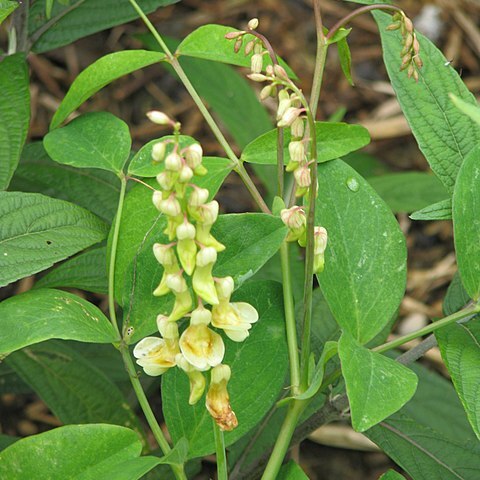Herbs perennial, with tuberous roots, 1-1.8 m tall. Stem strong, erect or decumbent, glabrous, wingless, hollow in lower parts. Leaves with strong, branched tendrils; stipules large, often similar to leaflets, semisagittate, ovate, 40-60 mm, entire or sometimes dentate at base; leaflets (2 or)3-or 4(or 5)-paired, usually ovate, 40-70 × 50-110 mm, glabrous, with reticulate veins, margin entire, apex mucronate. Raceme subequaling leaf, 10-40-flowered. Calyx campanulate, ca. 5 mm, glabrous, shortly toothed. Corolla yellow, maturing to orange, 1.5-2 cm; standard elliptic, with claw; wings subequaling standard, auriculate at base. Ovary linear, glabrous. Legume orange-brown, linear, 8-15 cm. Seeds purple-brown, broadly oblong, smooth. Fl. May-Jul, fr. Aug-Oct.
More
A herb. It keeps growing from year to year. It can be a climbing plant. It grows 80-100 cm high. The stems can be 3 m long. The leaves have leaflets along the stalk. There is a branched tendril at the end. There are 4-8 leaflets. They are oval and 3-10 cm long by 2-3 cm wide. The flowers are yellow. They are 2 cm long. They are along a stalk 10-20 cm long. The pods are cylinder shaped and 8-11 cm long. The seeds are oblong and brown.
Woods and thickets all over Japan. Hill slopes, forest sides and bush-woods; usually at elevations up to 1,800 metres.
More
It is a temperate plant. It grows wild in northern China. It grows below 1,800 m above sea level.
The young plants including stems pods and flower stalks are parboiled then eaten as a potherb, fried, roasted and use in soups. The leaves are stems can be cooked and eaten separately.
Can be grown by seedlings. Seeds needs soaking.

